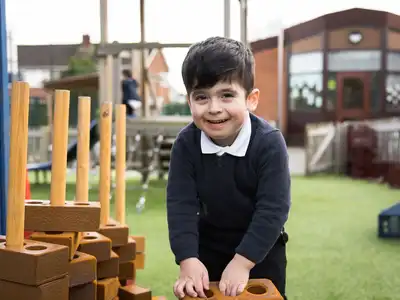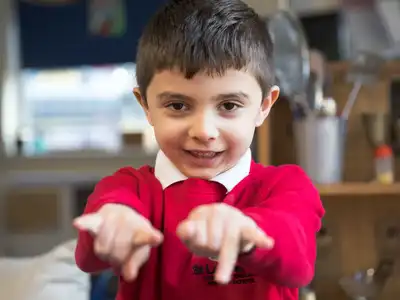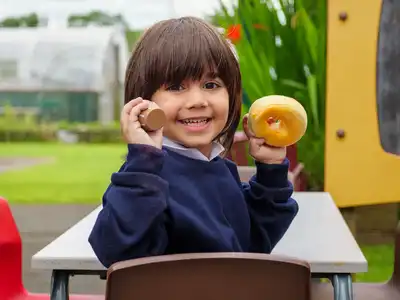Expert early years practitioners Dixie-Louise Dexter and Nicola Middleton explain how they have taught the characteristics of effective teaching and learning explicitly to support children to become motivated and independent learners.
Playing and exploring, Active learning, and Creating and thinking critically are three characteristics of effective teaching and learning defined in the early years foundation stage statutory framework.
At Ashby Hill Top Primary School, we treat the three characteristics as central to all we do. We know that without these skills and characteristics, children may not become independent, motivated, lifelong learners. The characteristics of effective teaching and learning are a statutory part of the Early Years Foundation Stage (EYFS) curriculum, so we wanted to ensure that all children mastered these. We wanted them to build on them throughout their school career too.
This case study is part of a series exploring the four overarching principles of the early years foundation stage: the unique child, positive relationships, enabling environments, and learning and development.
Understanding the characteristics
Historically in EYFS we monitored and recorded the development of characteristics, such as perseverance, but only when we saw them happening in the classroom. We realised that to ensure all children gain these behaviours we needed to teach them more explicitly and make room for them within our planning and our day. We needed to talk to the children about how to become a learner.
As EYFS teachers we studied and unpicked the ‘characteristics of effective learning’ when the Department for Education introduced them in 2012, and again when we adapted to ‘characteristics of effective teaching and learning’ in 2021.
Having a clear and shared understanding of what each of these looked like in young children helped us to identify, model and nurture these with our class. We chose vocabulary and phrases that the whole team would use when talking to children about their learning and play, and focused on the process rather than the outcome.
Teaching the characteristics
We began to show children examples of staff and other children working through problems, facing difficulties or developing their own ideas. This came in many forms such as:
- Narrating a child’s learning process back to them and others around as it was happening.
- Staff demonstrating the characteristics and describing their actions aloud.
- Discussing the characteristics that may be needed to complete an activity as it is introduced.
These are now an essential part of our daily practice.
We modelled ‘concentrate and keep on trying’, which is one of the skills in the Playing and Exploring characteristic, in a video. Our EYFS team recorded a video with two people doing the same task, but showing different learning processes and behaviours. In one video, the staff are putting on aprons at the paint easel. One person can’t get their arms into an apron and they give up. The other is successful after seeking help and persevering. Watching the video with children, class teachers narrate the learning process for both scenarios. They highlight the desirable learning behaviours they observed and the importance of this to being a successful learner. Class teachers also give verbal feedback to the adults in the video. They praise the adult who succeeded by putting emphasis on the learning behaviour of not giving up and keeping on trying. They give advice to the adult who left the apron, explaining what they need to do next time.
We rewarded children for how they learn, not just what they achieve and this became more explicit and shared over time.
At the end of each session staff now choose a few children who have shown desired learning characteristics and share them with the class. They discuss videos and photos of the child at work, showing where they took a risk or overcame a problem. The explicit discussion and reward increased the children’s understanding because it helps them see the characteristics as real not abstract.
We praise children for the characteristics they demonstrate, rather than for what they achieve. This vocabulary has become the everyday language used by children and staff alike. The children are proud when we recognise they have shown curiosity or made links with prior learning. They praise each other for these behaviours and want to master them themselves.
Developing lifelong learners
The impact of this change in focus has been far reaching. By focusing on teaching the children how to become learners we have found that their skills are better. They are more equipped to learn the knowledge and understanding elements of the EYFS curriculum. Their focus and motivation in teacher-directed activities and child-initiated play is high, which gives the classroom a calm and purposeful learning atmosphere.
Staff openly welcome children taking risks, learning by error and making mistakes, so children feel safe to do this. We give children undisturbed time to become fully engaged and absorbed in their chosen learning. This means they have more opportunities to develop the characteristics of effective teaching and learning.
We have built on the success of this approach to do further work on learning characteristics throughout the school. We have developed new characteristics for Key Stage 1 and Key Stage 2 to support our pupils to master further characteristics as they develop and mature. Staff in Years 1 to 6 teach, recognise and reward learning characteristics, helping to equip all our children to thrive and succeed as lifelong learners.
Start your journey with a team discussion about what each characteristic looks like in your setting. Reflect on whether your environment provides enough opportunities to practise the characteristics and how staff can nurture them.




